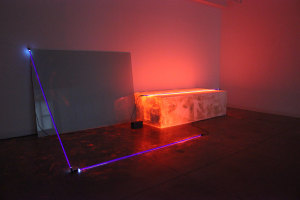
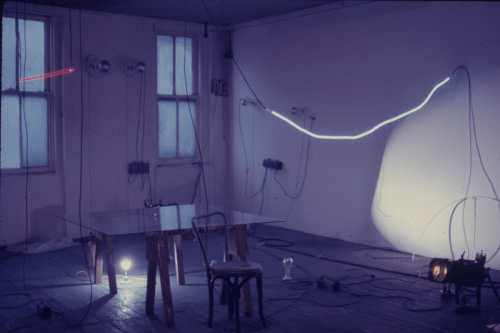
The Mulberry Street studio, circa 1969. Photograph by Richard Landry.
Lesley Raeside is an artist living in Connecticut. Lesley worked with Keith Sonnier for many years until his death in 2020. On the occasion of Castelli Gallery's summer exhibition Joseph Kosuth / Keith Sonnier, which includes the presentation of Ba-O-Ba Fluorescent, 1970, we have asked Lesley to share her first hand knowledge about this important work, which was first shown in Keith Sonnier's first solo exhibition with Castelli at Castelli Warehouse in 1970.
Keith had his first studio and living space in New York in a former factory building on Mulberry Street, with only cold water and no electricity, other than to bring power to the safety lights in the hallways. The walls and windows were covered with the kind of dust and sticky grime that resulted from years of city traffic. (1)
My favorite works by Keith were made in that first studio on Mulberry Street. I love the 35mm slides from the archive that show him surrounded by a burgeoning collection of “new” art materials from the hardware stores on Canal Street: silver-tipped incandescent lightbulbs, porcelain lamp holders, mirrors, foam rubber, and most importantly, extension cords (to bring electricity in from the hallways).
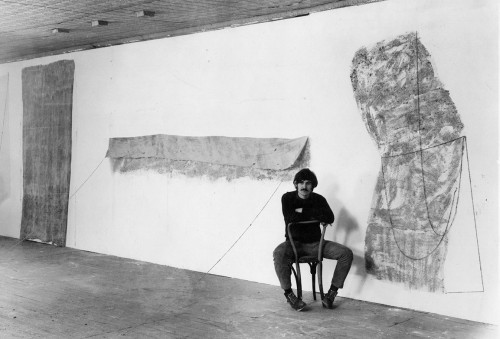
Keith Sonnier in his Mulberry Street Studio, circa 1968/69 with Flocked Wall (left), Mustee (center), and Untitled (right). Photograph by Peter Moore.
Peter Moore’s black and white photographs of Keith sitting in his studio with his recently completed ephemeral work (the latex and flock pieces applied to the wall, and then pulled off with string) are also beautiful. Keith spoke about wanting this particular body of work to be “banal” and “almost not there” (2) -most likely alluding to its fleeting nature, but perhaps he’s also talking about how seminal works such as Flocked Wall and Mustee can be considered as appropriations of the wall in his studio before the dirt and grime were scrubbed off. One version of Flocked Wall requires sawdust to be combined with the flock each time it’s installed.
The archaic definition of the word “mustee” is “a person of one-eighth black ancestry,” but given Keith’s cavalier attitude to spelling, I can’t help but wonder (and wish I’d thought to ask), if Mustee was just his own unique and exotic way of spelling “musty”.

Keith Sonnier in a performance at the Mulberry Street Studio, circa 1969/70. Photograph by Richard Landry.
As much as Keith was influenced by his environment, his creativity was also versatile. Ideas conceptualized in the studio materialized time and again across many disciplines and a range of applications. Foam rubber, for instance, was everywhere in his work in 1970: performers manipulated foam props in the studio and then a video was made of the performance. Dickie Landry took black and white photos of the same performance and his photographs became a book (Object, Situation, Object). (3) Foam was also used with fluorescent pigments and ultra-violet light in sculptures and environmental installations such as Ba-O-Ba Fluorescent (1970), Dis-Play II (1970), and Fluorescent Room (1970).
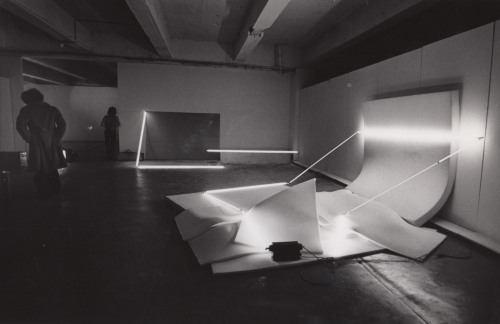
Installation view, Keith Sonnier, Castelli Warehouse, 1970. Background: Ba-O-Ba Fluorescent, Foreground: Ba-O-Ba VII. Photograph by Peter Moore.
Ba-O-Ba Fluorescent, currently on view at Castelli Gallery, was included in Keith’s first soloexhibition in the United States, at Castelli Warehouse in 1970. It is the only example from his career-long, predominantly glass and neon Ba-O-Ba series to include foam rubber, fluorescent powder, and ultra-violet light.
Keith was drawn to the “low-tech” qualities of foam and rejected using it in any way that implied weight or sculptural mass, which no doubt influenced his decision to cover, but not conceal it, with fluorescent powder. (4)
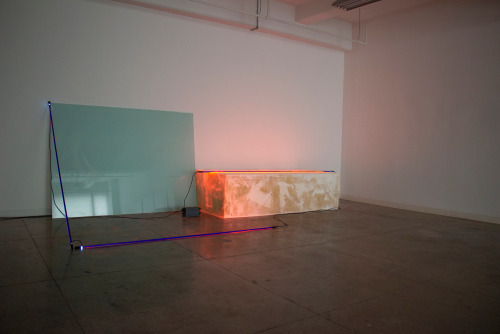
Ba-O-Ba Fluorescent, installation view, Joseph Kosuth / Keith Sonnier, Castelli Gallery, June 10 - July 25, 2024.
Castelli's Midtown gallery has a wall of windows that allows light to enter from the North providing a unique opportunity to view the sculpture in various lighting conditions. In the early afternoon, Ba-O-Ba Flourescent's components are laid raw and bare. The foam component is visible beneath a layer of caked pigment which could be easily mistaken for dust. It brings to mind, once again, the old factory building on Mulberry Street, but also my own forgettable experience of visiting the studio in Tribeca with Keith immediately after 9/11 to find every surface covered with the ashes from teh collapse of the Twin Towers.
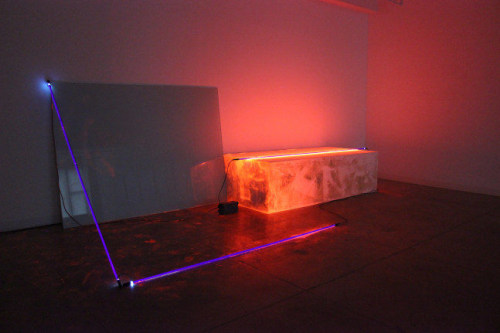
Ba-O-Ba Fluorescent, installation view, Joseph Kosuth / Keith Sonnier, Castelli Gallery, June 10 - July 25, 2024.
As daylight fades and the gallery darkens, the fluorescent pigment lights up: white turns to pink and ultimately to a red so intense that it resembles hot embers, creating the illusion of danger. The raw energy of electrically charged light is palpable as Ba-O-Ba Fluorescent transforms its immediate environment into a bath of color-saturated light.
Keith Sonnier was born in Mamou, Louisiana in 1941. He lived and worked in New York City, exhibiting with Castelli Gallery throughout his career. His last years were spent in Bridgehampton, between his country home and nearby studio. He died in Southampton in July 2020.
(1) Based on conversation with Jackie Winsor about the Mulberry Street Studio. She and Keith had studios and shared a living space there.
(2) Les Archives de la RTF: Video and interview with Keith Sonnier during the installation of the exhibit When Attitudes Become Form at Kunsthalle, Bern, 1969.
(3) Keith Sonnier: Object Situation Object, 1969-70. Artist Book: Object, Situation, Object, an image only, limited edition book (Edition of 1000) consisted entirely of Richard Landry's black and white photographs of a performance filmed at Mulberry Street.
(4) Arts Magazine, February 1971, Keith Sonnier at Eindhoven: An Interview with Willoughby Sharp.